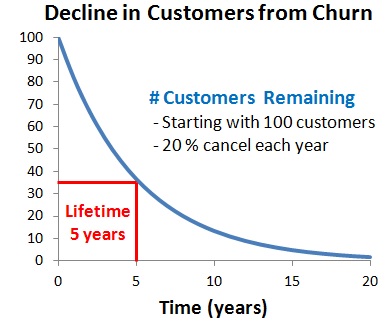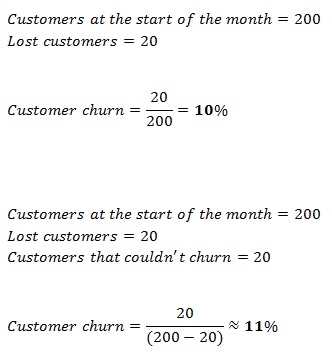If recurring revenue is the lifeblood of a SaaS business, high customer churn is its death knell, a warning sign that things are about to go seriously wrong.
Lost customers eat away at your growth, undermine the stability of your business, and wave a bright red flag in front of potential investors. If left unchecked, customer churn can become a big problem.
As Joel York of Chaotic Flow explains:
‘SaaS churn increases with the size of the customer base, so it is essentially negative virality, and as such is incredibly difficult to overcome. Graphically, SaaS churn tends to follow what is called a negative exponential distribution (shown below, it is the opposite of the positive exponential distribution associated with viral growth).’

Obviously, customer churn is a hugely important SaaS metric. By measuring the rate at which your customers cancel their subscriptions to your business, you can improve your predictions for future growth, and calculate customer lifetime value. You can take steps to improve your business model, and attract long-term customers (and investors).
While virtually everyone in the SaaS sector understands its importance, many struggle to calculate it accurately. To help you avoid the pitfall of underestimating customer churn, I’m looking at three common mistakes – and showing you how to overcome them.
1) Not All Customers Can Churn
The simplest churn calculations compare the number of users at the start of a time period (say a month) with the number of users at the end of the period.
Crucially, this calculation assumes that all customers are capable of churning over that period. With most SaaS business models, that won’t be the case. Over any given time period, there’ll be a portion of your customer base that won’t be able to churn: those that are still bound by their contract.
Including these customers into your churn analysis will distort your calculation, and make it look like your churn rate is lower than it actually is:

By factoring in non-churnable customers, we’ve revealed that our churn rate is actually 10% higher than we originally calculated it to be. For a growing business, underestimating churn by 10% will soon become a serious problem. Thankfully, there are two simple ways to avoid this happening:
- Calculate your average contract length, and measure customer churn over that time period.
- Only calculate churn for contracts that are ready for renewal.
2) Different Customer Types Distort the Measurement
There are always a handful of customers that shouldn’t be factored into primary churn measurements. For example, you may have seen an influx of sign-ups from a product bundle, where users subscribe to dozens of SaaS products in one fell swoop.
 While it is crucial to track the churn rates of these new users (primarily to evaluate the effectiveness of the marketing campaign that acquired them), including them in your main churn analysis could skew your calculations unfairly.
While it is crucial to track the churn rates of these new users (primarily to evaluate the effectiveness of the marketing campaign that acquired them), including them in your main churn analysis could skew your calculations unfairly.
Though technically ‘customers’, these new users are much more likely to churn than people that have specially sought out your product. Most importantly, they’ll have different reasons for churning.
To overcome this problem, it’s important to define what you mean by a customer – whether it’s a user that’s stuck around for 2+ billing cycles, or a user that’s demonstrably engaged with your product.
3) You Don’t Create Churn Cohorts
Churn is an important SaaS metric, but measuring it isn’t a goal in its own right. We want to measure churn to reveal problems with our business model, and find ways to encourage long-term customers.
To create a useful churn metric, we need to be discerning with the people we include in our calculations. We need to restrict our primary churn analysis to the people that are most representative of our user base; and separate different customer types into churn cohorts.
Customer churn will be influenced hugely by the length of their contract, their monthly spend, and the attitudes and priorities of each customer. Instead of grouping them all together into a single calculation, it’s better to separate customers out into groups with similar attributes.
Measuring churn separately over each of these cohorts will give much greater insight into the factors behind customer churn – and make it easier to address them. So, before your next churn calculation, dig-down into your CRM, and create a handful of distinct churn cohorts (your SaaS buyer personas can be extremely helpful for this).





